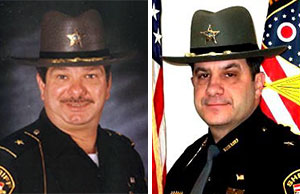Stark County Sheriff Not Qualified to Hold the Office

Former Stark County Sheriff Timothy Swanson (left) has been reinstated as acting sheriff in the county following today’s Supreme Court decision that current Sheriff George T. Maier is unqualified for the job.

Former Stark County Sheriff Timothy Swanson (left) has been reinstated as acting sheriff in the county following today’s Supreme Court decision that current Sheriff George T. Maier is unqualified for the job.
The Supreme Court of Ohio today ordered the removal of the Stark County sheriff from office because he does not meet the legal qualifications to be sheriff.
In its 5-2 per curiam (not authored by a specific justice) decision, the court reinstated the prior acting county sheriff until a qualified candidate can be appointed.
In 2012, Michael A. McDonald was elected as sheriff of the county but could not take office the following January because of health reasons. The Stark County commissioners appointed Timothy A. Swanson – who had been sheriff for more than a decade and had decided not to run again in 2012 – as acting sheriff until someone could be appointed to fill the office.
McDonald was a Democrat, so the Stark County Democratic Central Committee was responsible for appointing a qualified person to fill the position under R.C. 305.02(B). Three candidates applied. Though several members raised concerns about his qualifications, the committee appointed George T. Maier as the new sheriff in early 2013.
Swanson filed a writ in quo warranto (challenging a person’s right to hold office) with the Supreme Court claiming that Maier was not qualified to be sheriff.
In its opinion today, the court first determined that Swanson had the legal right to file the action, because he had been lawfully appointed as acting sheriff, made his claim in good faith and on reasonable grounds, and only asserted that he is entitled to hold the office until a qualified applicant is appointed.
In reviewing Maier’s qualifications, the court explained that a candidate for county sheriff must meet the qualifications set out in either R.C. 311.01(B)(8)(a) or (B)(8)(b), plus the requirements in either R.C. 311.01(B)(9)(a) or (B)(9)(b).
Maier asserted that he is qualified under (B)(8)(a). Under that subsection, the court said he must have held or obtained a valid certificate of peace-officer training within the four years immediately prior to the qualifying date of February 6, 2013, and also have been employed within the four years immediately prior to that date as a highway patrol officer or “‘as a full-time peace officer as defined in section 109.71 of the Revised Code performing duties related to the enforcement of statutes, ordinances, or codes.’”
From May 2007 to January 2011, Maier was assistant director and, briefly, interim director of the Ohio Department of Public Safety. While employed as assistant director, he was appointed as an enforcement agent in the department’s Ohio Investigative Unit from July 2008 to January 2011.
The court found that Maier was a “peace officer” while serving as an enforcement agent. It also determined that he clearly was a full-time state employee, as defined by the Ohio Administrative Code, while he worked at the public safety department. The court then turned to whether he served as a “full-time peace officer” in this role.
The court adopted a 2001 state attorney general’s opinion stating that a person is employed as a full-time law enforcement officer when his work as a law enforcement officer takes all of his regular working hours.
While many of Maier’s responsibilities qualified as law enforcement, his job also included supervising the department’s human resources office, equal opportunity programs, and collective bargaining, as well as establishing the department’s goals and crafting policies. His job description indicated that criminal investigation was 40 percent of his job.
Because his duties as a peace officer did not fill all of his regular working hours, the court concluded that Maier “was not a ‘full-time peace officer’ as required by R.C. 311.01(B)(8)(a).”
The court’s majority opinion was joined by Chief Justice Maureen O’Connor and Justices Terrence O’Donnell, Judith Ann Lanzinger, Sharon L. Kennedy, and Judith L. French.
Justice Paul E. Pfeifer dissented in an opinion joined by Justice William M. O’Neill.
In his dissent, Justice Pfeifer cited a dissenting opinion he wrote in 2000 (State ex rel. Wolfe v. Delaware Cty. Bd. of Elections) in which he described R.C. 311.01 as “overly restrictive without a rational basis,” concluding that it denies Ohio citizens a “meaningful choice” in sheriff elections. In that dissent, he noted that the Ohio attorney general is unqualified for county sheriff under the statute. He questioned the court’s decision to now find that a former assistant director of public safety is not qualified as well.
Justice Pfeifer contended that an Ohio Investigative Unit enforcement agent; a full-time assistant director of public safety who worked with agents in the field and in surveillance, made arrests, and carried a badge and a weapon; and a person who directed other law enforcement state agencies meets the statutory requirements for the office.
“That the person also supervised the human-resources office, defined the department’s goals, and formulated the department’s policies is more an indication of competence than, as stated in the majority opinion, a reason for automatic disqualification,” he wrote.
2013-0274. State ex rel. Swanson v. Maier, Slip Opinion No. 2013-Ohio-4767.
Please note: Opinion summaries are prepared by the Office of Public Information for the general public and news media. Opinion summaries are not prepared for every opinion, but only for noteworthy cases. Opinion summaries are not to be considered as official headnotes or syllabi of court opinions. The full text of this and other court opinions are available online.
Acrobat Reader is a trademark of Adobe Systems Incorporated.


